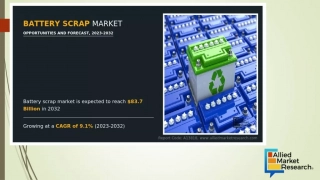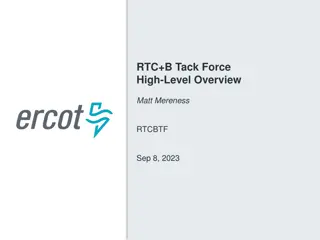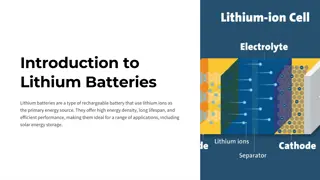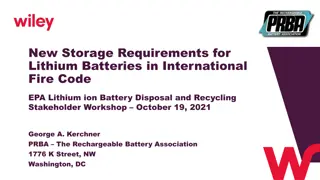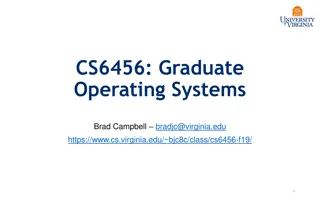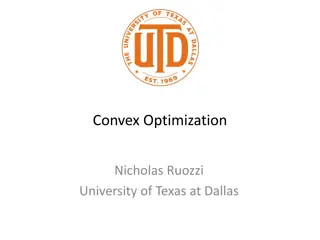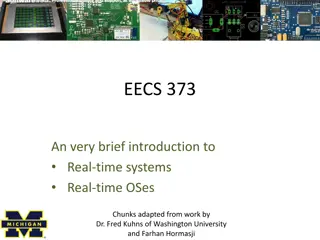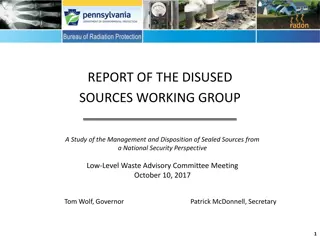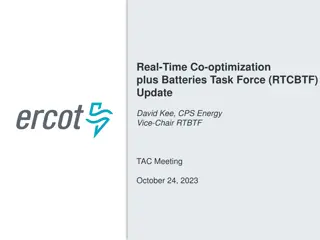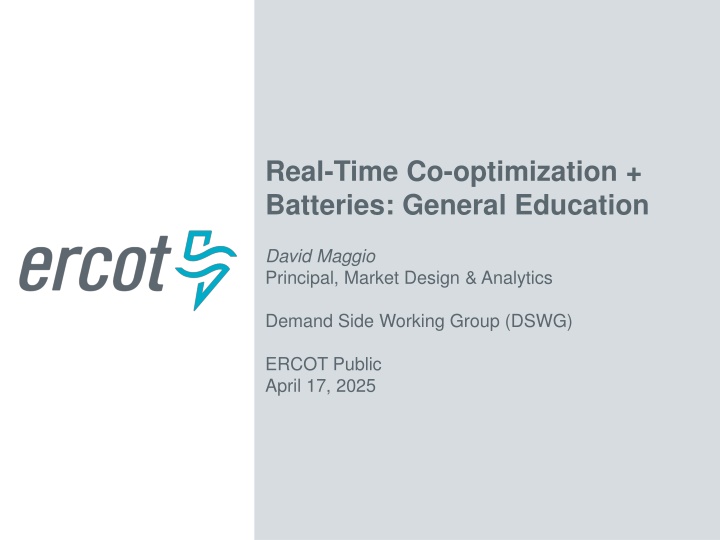
Real-Time Co-optimization and Batteries: Transforming Energy Markets
Explore the significance of Real-Time Co-optimization plus Batteries (RTC+B) project in ERCOT, its impact on market dynamics, potential cost savings, and the co-optimization of energy and ancillary services. Discover how this innovative project is reshaping the energy landscape for improved efficiency and savings.
Download Presentation

Please find below an Image/Link to download the presentation.
The content on the website is provided AS IS for your information and personal use only. It may not be sold, licensed, or shared on other websites without obtaining consent from the author. If you encounter any issues during the download, it is possible that the publisher has removed the file from their server.
You are allowed to download the files provided on this website for personal or commercial use, subject to the condition that they are used lawfully. All files are the property of their respective owners.
The content on the website is provided AS IS for your information and personal use only. It may not be sold, licensed, or shared on other websites without obtaining consent from the author.
E N D
Presentation Transcript
Real-Time Co-optimization + Batteries: General Education David Maggio Principal, Market Design & Analytics Demand Side Working Group (DSWG) ERCOT Public April 17, 2025
Agenda Why is the Real-Time Co-optimization plus Batteries (RTC+B) project so important? What does it mean to co-optimize? What components of the market are changing with Real-Time Co-optimization (RTC)? How is this impacting communications between ERCOT and Market Participants? What is the plus Batteries part of the project? What is the timeline for testing and implementation of the project? ERCOT Public
Why is the RTC+B project so important? ERCOT Public
Estimated annual savings of RTC+B compared to 2018 IMM report The Independent Market Monitor (IMM) and ERCOT have both done back-cast studies to assess the operational and market efficiencies with RTC+B. These studies have consistently shown potential cost savings to the market in excess of $2 billion per year. Key Takeaway: IMM 2018 study of Operating Year 2017 estimated $2 billion in cost savings. ERCOT 2024 study of more recent years shows $2.5 $6.4 billion estimated annual cost savings, representing 17-21%. 4 ERCOT Public
ERCOT installed net generation capacity (as of April 1, 2025) End of 2028 (MW) [Based on GIS Info] WIND: ~ 46,000 PV: ~ 72,000 ESR: ~ 38,000 5 ERCOT Public
What does it mean to co-optimize? ERCOT Public
Under RTC, energy and Ancillary Services are co- optimized, but what does it mean to co-optimize? Currently Gen 1 Gen 2 Ancillary Service Capacity $/MWh $/MWh 300 50 150 80 20 10 MW MW 150 250 300 400 50 200 $10/MWh $10/MWh $20/MWh $150/MWh The placement of Ancillary Services on Resources across the ERCOT System is assumed. 7 ERCOT Public
Under RTC, energy and Ancillary Services are co- optimized, but what does it mean to co-optimize? Under RTC Gen 1 Gen 2 Ancillary Service Capacity $/MWh $/MWh 300 50 150 80 20 10 MW MW 150 250 300 400 50 200 Ancillary Service offer $10/MWh Ancillary Service offer $20/MWh $10/MWh $60/MWh By awarding the Ancillary Services to another Resource, overall costs are reduced. 8 ERCOT Public
What components of the market are changing with RTC? ERCOT Public
Todays market is designed to reflect scarcity through a process that is outside of the optimization Currently Energy Offers Base Points Security- Constrained Economic Dispatch (SCED) Telemetry Locational Marginal Prices (LMPs) Combined to form Settlement Point Prices Constraints Operating Reserve Demand Curve (ORDC) Price Adders Reserve Pricing 10 ERCOT Public
The ORDC sets the value of ERCOT System reserves 6000.00 5000.00 Value of Reserves ($/MWh) ORDC Price Adders determined based on level of reserves 4000.00 3000.00 2000.00 1000.00 0.00 0 1000 2000 3000 Available Reserves (MW) 4000 5000 6000 7000 8000 11 ERCOT Public
RTC is also designed to reflect scarcity, but now it occurs within the optimization Under RTC Energy & Ancillary Service Offers Base Points Form Settlement Point Prices LMPs Telemetry SCED Ancillary Service Awards Constraints Ancillary Service Demand Curves (ASDCs) Ancillary Service Prices 12 ERCOT Public
Unlike todays market, the cost of Ancillary Services is factored directly into LMPs Today, the need for an additional MWh of energy results in the price of energy (i.e., the LMP) going from $30/MWh to $50/MWh The next MWh would come from Gen 2 Ancillary Service Offer = $10/MWh Ancillary Service Offer = $20/MWh Ancillary Service Capacity Energy Offer = $30/MWh Energy Offer = $50/MWh Gen 1 Gen 2 ERCOT Public
Unlike todays market, the cost of Ancillary Services is factored directly into LMPs Example: With RTC, Ancillary Services can be reallocated to access cheaper energy from Gen 1. However, this has the effect of increasing Ancillary Services cost. This means the LMP goes to $40/MWh ($30/MWh for the energy from Gen 1 plus the $10/MWh of additional Ancillary Service cost) Ancillary Service Price: $10/MWh $20/MWh Ancillary Service Offer = $10/MWh Ancillary Service Offer = $20/MWh Ancillary Service Capacity Ancillary Service Capacity Energy Offer = $30/MWh Energy Offer = $50/MWh Gen 1 Gen 2 ERCOT Public
Instead of using the ORDC, under RTC, scarcity pricing and the value of reserves is set by individual ASDCs Sufficient remaining capacity and offers Insufficient remaining capacity or offers $/MWh $/MWh MW MW Demand Offer Demand Offer Value of the Ancillary Services 15 ERCOT Public
ASDCs will be based on the shape and pricing outcomes of the current ORDC mechanism Price ($/MWh) Price ($/MWh) Available Reserves (MW) Available Reserves (MW) Reg-Up RRS ECRS Non-Spin Reg-Up RRS ECRS Non-Spin Price ($/MWh) Price ($/MWh) Available Reserves (MW) Available Reserves (MW) ERCOT Public
Having individual ASDCs allows RTC to better distinguish and prioritize between various Ancillary Service products Reg-Up RRS Price ($/MWh) ECRS Non-Spin The prioritization is set by the ASDC price Available Reserves (MW) What should the optimization do when it can t procure all the desired Ancillary Services and meet electric demand? The ASDCs help to make this decision where much of the Regulation Up (Reg-Up) and RRS is given priority over ECRS and Non-Spin. 17 ERCOT Public
While the primary focus is the Real-Time Market, changes to other parts of the wholesale market are also part of RTC Operating Hour Performance Hour-Ahead Settlement Monitoring Reporting SASM DAM RUC RUC Day-Ahead Operations Adjustment Period Operating Period Post Real-Time ERCOT Public
Reliability Unit Commitment (RUC), like Real-Time, currently takes Ancillary Service assignment to individual Resources as a known input Ancillary Service capacity is assigned to Resources by Market Participants to fulfill Ancillary Service Supply Responsibilities Ancillary Service Capacity RUC attempts to meet forecasted demand and solve transmission congestion with remaining capacity, not reserved for Ancillary Services Available for Energy Dispatch Currently System Capacity 19 ERCOT Public
To better reflect and plan for Real-Time grid conditions with RTC, RUC will also be modified to co-optimize energy and Ancillary Services Available for Energy Dispatch or Ancillary Services RUC demand, solve transmission congestion, and meet system Ancillary Service needs using the full capability of Resources planned to be available attempts to meet forecasted Under RTC System Capacity 20 ERCOT Public
The current DAM fundamentally stays the same with the implementation of RTC Energy Offers & Bids Energy Awards Point-to-Point (PTP) Obligation Bids PTP Obligation Awards DAM Ancillary Service Offers* Ancillary Service Awards ASDCs * With RTC, virtual Ancillary Service Offers will be allowed. 21 ERCOT Public
The current SASM process will be eliminated with the implementation of RTC SASM allows ERCOT to fill Ancillary Service gaps that appear after completion of the DAM 1. Failure to provide 2. Infeasible Ancillary Service capacity Ancillary Service Awards SASM 3. More Ancillary Service capacity needed 4. Insufficient Ancillary Service offers in the DAM Under RTC, a co-optimized RUC and the Real-Time Market fulfill this role. 22 ERCOT Public
Changes in RTC will also impact performance monitoring Generation Resource Energy Deployment Performance (GREDP) and Controllable Load Resource Energy Deployment Performance (CLREDP) calculations will be updated to account for changes made to deployments instructions from ERCOT, specifically the transition to Updated Desired Set Point. Equivalent changes also being made to Base Point Deviation settlement processes. 2 major compliance requirements and associated reporting are eliminated: With RTC, the concept of a physical Ancillary Service obligation based on DAM awards, self-arrangement, and trades is no longer relevant. Instead, these forward transactions only create a financial obligation. With changes in Real-Time to Ancillary Service deployment, the updating on Ancillary Service Schedules following instruction for the purpose of adjusting High Ancillary Service Limits (HASLs) is no longer relevant. 23 ERCOT Public
How is this impacting communications between ERCOT and Market Participants? ERCOT Public
With RTC, there will be several changes in the data flow between ERCOT and Qualified Scheduling Entities (QSEs) Currently Under RTC Ancillary Service Resource Capabilities & Real-Time Ancillary Service Awards Ancillary Service Resource Responsibilities Ancillary Service-Specific Resource Statuses More General Resource Statuses Regulation Service Participation Factors/QSE-Level Deployments Resource-Specific Regulation Deployments Updated Desired Set Points Updated Desired Base Points Real-Time Ancillary Service Prices ORDC Price Adders Some of these affect both Real-Time (telemetry) and Adjustment Period (COP) communications between ERCOT and QSEs. 25 ERCOT Public
There will also be changes to many reports, extracts, and dashboards Examples: New Going Away Modified 1. Ancillary Service Disclosure reports for Real-Time 2. Real-Time Ancillary Service prices 3. ASDCs 1. SASM reports 2. ORDC reports 3. Ancillary Service Supply Responsibility reports and notifications 1. Other Disclosure reports 2. Performance Monitoring reports 3. Market submission validation rules 4. Short-term system adequacy reports 5. Ancillary Service capacity monitor 26 ERCOT Public
What is the plus Batteries part of the project? 27 ERCOT Public
Energy Storage Resources (ESRs) will now be fully seen as a single device within ERCOT s systems Currently Future High Sustained Limit (HSL) HSL Ancillary Services Ancillary Services Discharge Generation Resource Controllable Load Resource Ancillary Services Discharge 0 0 Ancillary Services Charge No extra coordination needed Charge Reduced administration for ERCOT and QSEs Real-time market and RUC systems will change to capture capabilities and characteristics of ESRs. Ancillary Services Ancillary Services Max Power Consumption (MPC) Low Sustained Limit (LSL) 2 Current Operating Plans 2 sets of telemetry Submission dependencies 2 Resources 28 ERCOT Public
What is the timeline for testing and implementation of the project? ERCOT Public
There are several testing activities planned for ERCOT and QSEs prior to implementation of the project 30 ERCOT Public
Thank You! 31 ERCOT Public


